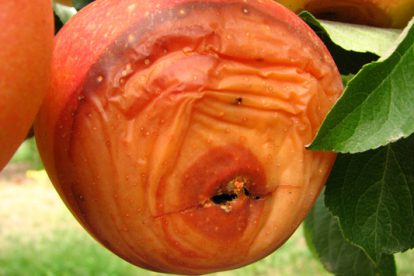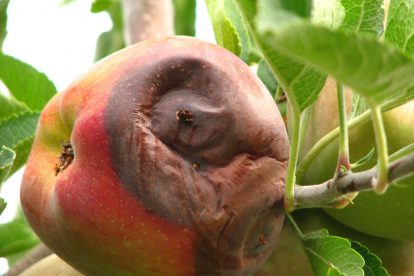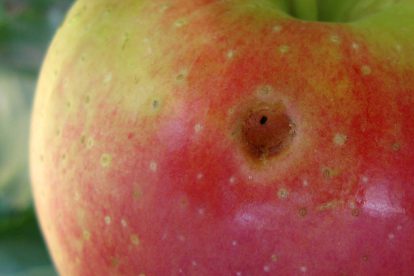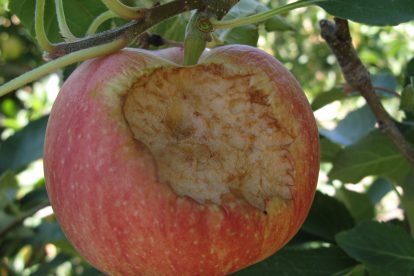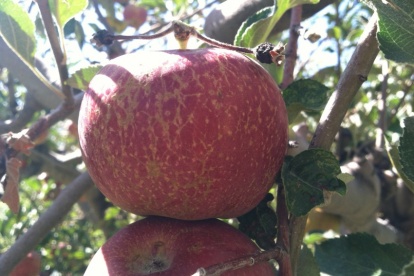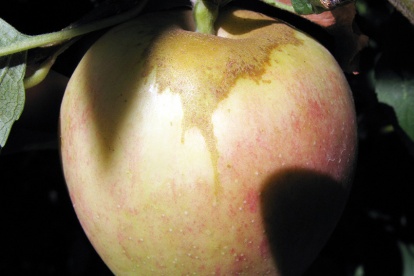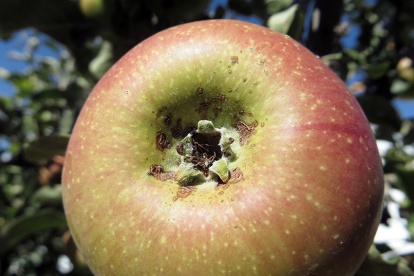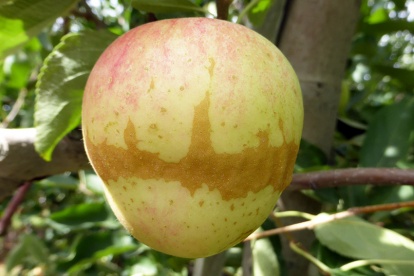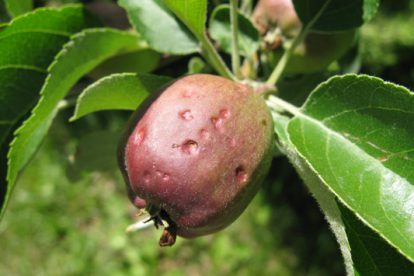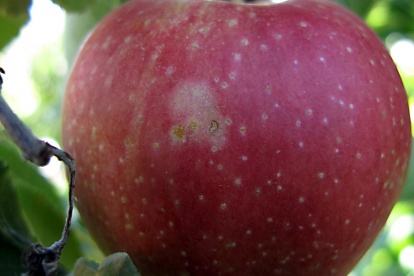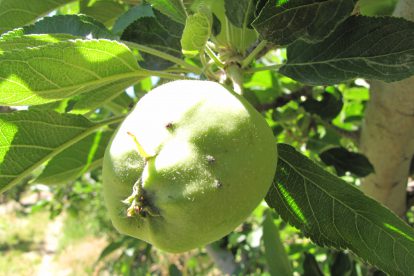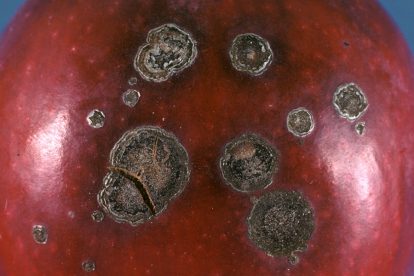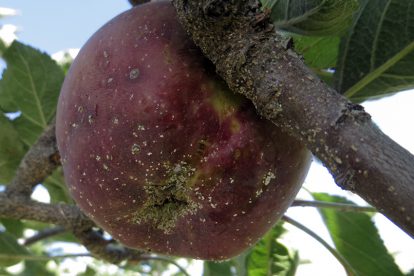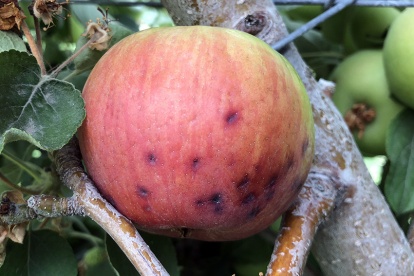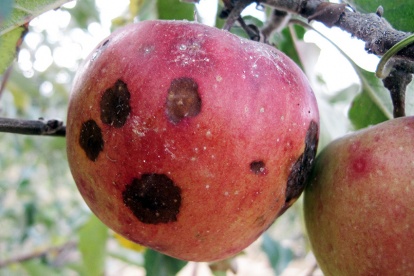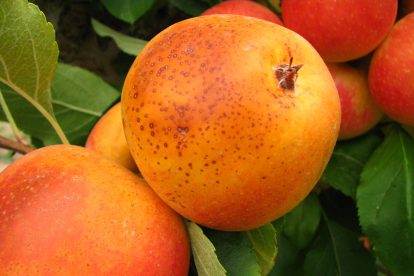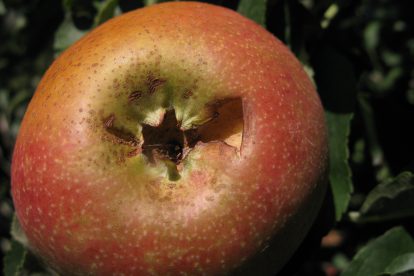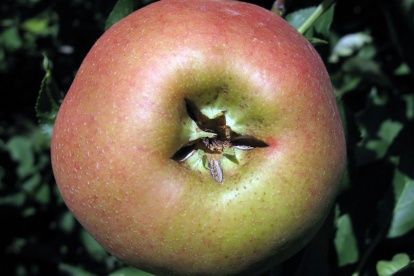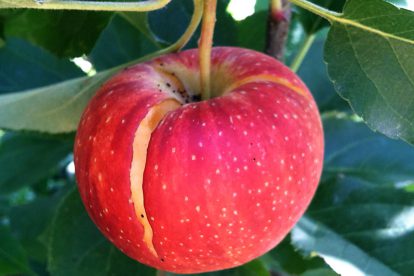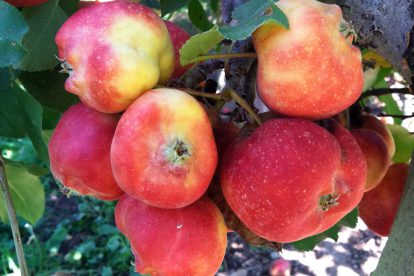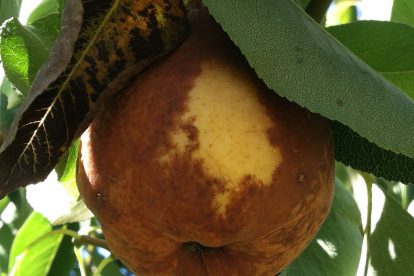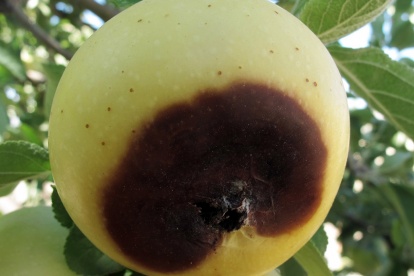In This Issue
Apple and Pear
- For fire blight, inspect trees and flag infected twigs and limbs to easily find them for removal at winter pruning.
- For blister mites, apply sulfur or 1.5% horticultural oil
- Watch temperatures and fruit for possible freeze damage
- Check out the image gallery below for damage that may be seen at harvest
Peach/Nectarine, Apricot, Plum
- Prevent new coryneum blight (shothole) infections this fall by applying copper to trees when 50% of the leaves have fallen. Use enough pressure to blow off remaining leaves.
General Orchard Chores
APPLE, PEAR
Fire Blight
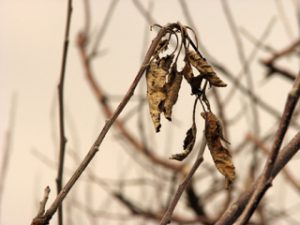
This winter, it is important to remove fire blight-infected twigs and limbs to prevent further spread next spring. But sometimes the infected areas are hard to find. Make it easier on yourself by inspecting trees this fall and marking fire blight damage with flagging. That way, the limbs are easy to find during the dormant season pruning.
If you are making inspections after leaf drop, look for twigs that still have the leaves attached, as this usually indicates a dead shoot.
If there are crabapple, hawthorn, or ornamental pear nearby, inspect and flag branches on those trees as well, and plan to prune them at the same time.
When pruning fire blight on dormant trees, it is not necessary to sterilize pruners between cuts. Cut the affected shoots 8 to 12 inches below the visible symptoms.
If you are diligent about removing as much fire blight as possible, you are lessening the chances of an outbreak next season.
Blister Mites
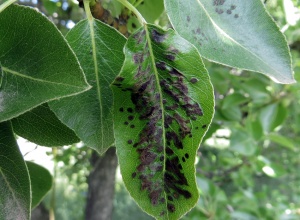
Blister mites can be treated now, and no later than just before leaf drop. This pest is more of an aesthetic problem, primarily on backyard trees, and does not harm the health of the tree. In fact, they serve as a food source for early-emerging predatory mites in the spring. (In turn, the predatory mites will take care of the harmful spider mites that are active during summer.)
However, if treatment is desired, one of the following could be used:
- 1.5-2% oil, thoroughly covering the bottoms of the leaves
- Sevin (carbaryl), alone or with 1% oil
- lime-sulfur (at this time of year only, it is OK to mix with 1% oil, but not on drought-stressed trees)
Blister mites belong to a group of mites called eriophyid mites (air-ee-oh-FYE-id). They are so small that they are invisible to the naked eye, but their feeding can cause visible symptoms.
Small raised blisters form on the leaves of pear and apple, which–by the middle of summer–look like brown or black leaf spots. In the fall, infested leaves will change color and drop before the healthy leaves.In early fall, just as the leaves start to turn color, the mites migrate to leaf buds to spend the winter under the bud scales. Their exposure at this time makes it a good opportunity to treat.
Freeze Damage to Apple
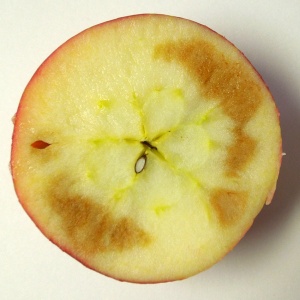
A hard freeze warning is in effect for Wednesday and Thursday evenings, with cooler temperatures for Thursday at 18 to 20 degrees F. I would like to share some expert information from a fruit consultant in Utah County, who says:
“Low temperature will freeze the fruit surface. The degree of damage will depend on the duration of the temperature at 20F or less. The cold temperature air mass will be deep and there will be very little altitude difference (the top of Nebo will only be 1 or 2 degrees colder than Santaquin). In addition, wind conditions and dew points will be unfavorable, so wind machines will not be useful.
I have experienced this type of event several times in the last 70+ years and the result is extremely difficult to predict. The things working in the growers’ favor are that this is a one-night event with the day before and the day after being 6 to 8 degrees warmer, which should allow the fruit to thaw out fairly quickly.
However, if the duration of the temperature at 20F or below is too long, the fruit could freeze to the core which will increase the chance that the damage will be severe.
Unfortunately, there is essentially nothing that can be done under these circumstances. I have experienced both total crop loss and no adverse effect under these circumstances.
Growers will need to make an assessment of the fruit condition on the trees before resuming harvest. It will take 3 or 4 days before fruit condition can be known.”
Apple Maladies Seen at Harvest – Image Gallery
PEACH/NECTARINE, APRICOT, PLUM
Coryneum Blight
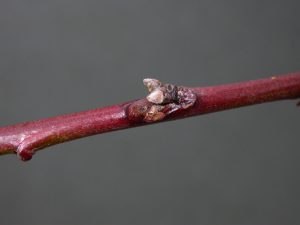
The time to treat coryneum blight (also known as shothole) is coming up. Optimally, it should be done when 50% of leaves have dropped from the trees.
Use a product that contains one of the following ingredients:
- copper (Bonide Copper, Lily Miller Microcop, Kocide, C-O-C-S, etc.)
- chlorothalonil (Daconil, Fertilome Broad Spectrum, Ortho Max Disease Control, etc.)
This disease affects many parts of the tree, including buds, small twigs, leaves, and fruit, so it is important to prevent new infections from happening in the fall.
When leaves drop, they leave a small open scar, and if any spores land on those scars under the right weather conditions, the fungus will invade the tissue and kill the bud. It is these bud infections that then lead to new leaf and fruit infections the following spring.
If trees have severe infections, it will take at least three years of diligent fall, spring, and summer treatments to suppress the disease incidence.
Other Orchard Chores
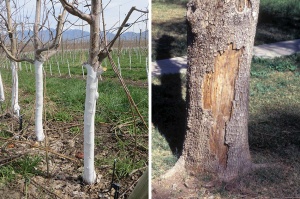
Keep roots moist: At this time of year, leaves on trees are changing color and dropping, while underground, major root growth is occurring. So it is important to maintain adequate but not excessive soil moisture from now until the soil freezes for winter.
Do not fertilize now: Roots will continue to grow all through fall, but nutrient uptake essentially ceases after the leaves have dropped. It is too late for any fall fertilizer applications, as whatever is applied will leach out of the soil.
Prevent winter sunscald: In late winter, bark can be warmed by intense sunlight. If this warming is followed by a cold spell that night, the bark can be killed. Sunscald is one of the primary problems affecting young trees in Utah and is a major factor in the incidence of cytospora canker or flatheaded borers. Protect trunks by applying white tree wrap or painting the trunk and lower scaffold limbs with a 1:1 mixture of white latex paint to water. If using tree wrap, remove it in early April.
Tree removal: Trees suffering from significant insect, disease, or other problems should be removed now. There is still time to install replacement plantings this fall.
Protect from mice, voles: Create or maintain at least 3 feet of clear space from around the base of each tree to help minimize rodents from feeding on bark and roots. Young trees are particularly susceptible to girdling because their trunk circumference is so small. Consider installing a physical barrier around the trunk and down into the soil up to 6 inches.

